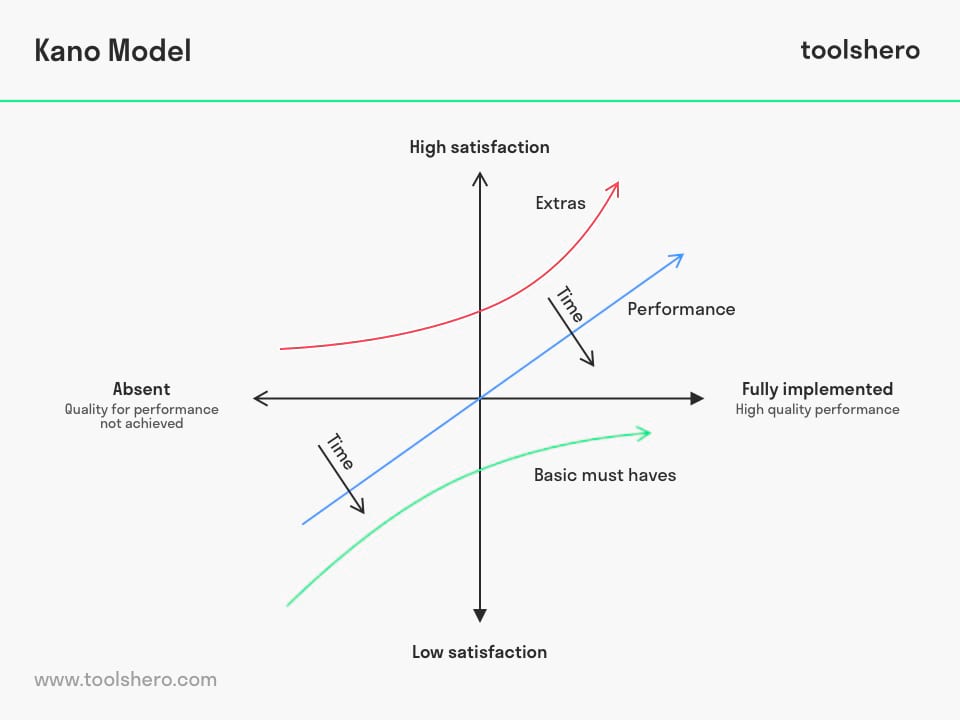Kano Model explained

Kano Model of Customer Satisfaction: this article explains the Kano Model of Customer Satisfaction by Noriaki Kano in a practical way. Next to what is the Kano model, this article also highlights the concept of Customer satisfaction and customer needs and the product attributes. After reading you will understand the basics of this marketing tool. Enjoy reading!
Customer satisfaction and customer needs
Customer satisfaction is becoming more and more important for businesses. If product development can be adjusted to accommodate the customer needs and requirements, this may increase customer satisfaction to some extent.
The Japanese professor Noriaki Kano developed a theory of product development and customer satisfaction in the 1980s. This model is known as the Kano model.
The Kano Model of Customer Satisfaction is based on needs of the customer: 3 types
The Kano model starts from three types of customer needs:

Figure 1 – Kano Model of Customer Satisfaction
Satisfying basic needs
This concerns the attributes that a producer needs to take into account with respect to attracting and retaining customers. These are basic attributes such as good packaging, excellent operation and a good price/ quality ratio.
Satisfying performance needs
In addition to the basic needs, customers can be won over by multiple items to buy a product or service. The more products or services a business has to offer, the more a customer can benefit from these. This may involve additional modifications, service or free by-products.
Satisfying excitement needs
In addition to performance needs, there are exciting qualities; these are attributes that exceed the customer’s expectations. The customer had not realized that they needed something extra but when offered they will scoop it up.
When there is a glut of extras, a company will run the risk that customer will experience these extras as ‘nothing special. For example eiderdowns on the beds in hotels instead of blankets and sheets.
Categories of the Kano model
In addition to customer needs, Kano believes that customer preferences can be divided into five categories. It is possible that they overlap with customer needs:
Attractive quality
When delivered, these product features trigger customer satisfaction but when not delivered, they do not cause dissatisfaction. They are product features that could surprise the customer. A label with an inbuilt thermometer on a bottle of wine will delight the customer because they will experience such an attribute as a positive and unexpected bonus.
One-dimensional quality
These attributes result in customer satisfaction when fulfilled but in dissatisfaction when not fulfilled. These are product attributes that companies use as competitive tools. For example a 10% discount when buying two bottles of wine. If it appears that the bottles have less content than the average bottle of wine, the discount will be 7% at most. As a result, the customer will feel misled.
Must-be quality
The product attributes are almost taken for granted by the customer. However, when they are not fulfilled they will result in the customer’s dissatisfaction. A customer will automatically assume the wine does not drip down the side of the bottle when poured. If it appears that the bottle is faulty and the wine sloshes out when poured, it will result in dissatisfaction.
Indifferent quality
These are attributes that relate to parts of which a customer cannot determine whether they are good or bad in advance and at a later stage. The label of a wine bottle is primarily intended to inform the customer about the type of wine and its origin. When this label comes off the bottle, this does not have to be a problem for the customer.
Reverse quality
These product features refer to a high degree of quality and performance, which does not always result in customer satisfaction. As customers are not all alike. One customer may perceive a high-tech innovation as a welcome product characteristic whereas this may irritate another customer who does not care for all those bells and whistles.
Product attributes through the Kano model
The Kano model offers insight into the product attributes that are perceived to be important to a customer and that could win them over to buy a product. The underlying purpose of the Kano model is to adjust and improve products using customer requirements.
The Kano model starts from the assumption that product attributes and does not focus initially on customer requirements. In order to find out these needs and requirements, Noriaki Kano also developed a methodology for mapping customer responses to questionnaires.
It’s Your Turn
What do you think? Is the Kano Model applicable in today’s modern economy and marketing? Do you recognize the practical explanation of do you have more suggestions? What are your success factors for the good Kano Model set up?
Share your experience and knowledge in the comments box below.
More information
- Kano, N. (1995). Upsizing the organization by attractive quality creation. In Total Quality Management (pp. 60-72). Springer Netherlands.
- Kano, N. et al. (1984). Attractive quality and must-be quality. Journal of the Japanese Society for Quality Control, 14 (2) (1984), pp. 39–48.
- Sauerwein, E., Bailom, F., Matzler, K., & Hinterhuber, H. H. (1996). The Kano model: How to delight your customers. In International Working Seminar on Production Economics (Vol. 1, pp. 313-327).
- Simmank, D. (unknown). Using the Kano-Model as an Approach to Evaluate Customer Satisfaction. Grin Verlag.
- Wang, T., & Ji, P. (2010). Understanding customer needs through quantitative analysis of Kano’s model. International Journal of Quality & Reliability Management, 27(2), 173-184.
How to cite this article:
Van Vliet, V. (2013). Kano Model. Retrieved [insert date] from Toolshero: https://www.toolshero.com/marketing/kano-model/
Original publication date: 09/30/2013 | Last update: 06/20/2023
Add a link to this page on your website:
<a href=”https://www.toolshero.com/marketing/kano-model/”>Toolshero.com: Kano Model</a>












